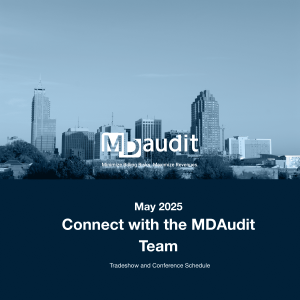Just as the pandemic tamped down demand for medical services, private payers and federal agencies dialed back the number of claims audits being performed. But with the end of the public health emergency in May, audit activity is poised to resume at higher levels.
The Centers for Medicare & Medicaid Services (CMS) finalized a rule in January that’s expected to claw back $4.7 billion from Medicare Advantage (MA) plans over the next decade by conducting audits back to 2018. Because of the attractive return on investment (ROI) realized by these anti-fraud activities, federal agencies have increased spending on integrity programs, including using artificial intelligence (AI) and machine learning (ML) to audit more claims.
In the 2023 Semi-Annual Report to Congress from the Office of Inspector General (OIG) that covers October 2022-March 2023, the agency identified $200.1 million in expected audit recoveries and $277.2 million in questioned costs.
“It’s not a question of whether your organization is going to be audited, it’s a question of when,” says Dana Finnegan, Director of Market Strategy, MDaudit. “The key to a successful audit is to create a robust billing compliance program that uses an effective combination of people, process, and technology.
3 Potential Impacts of an OIG audit
When the OIG comes calling, it will be “all-hands-on-deck” for your organization. Keep in mind these risks in failing to respond effectively to an audit.
1. Lost Resources
In a survey prior to the pandemic, nearly one-quarter of hospitals report responding to 500 to 2,000+ external audit-related requests every month. Each response takes considerable resources and staff effort — at a time when revenue cycle management (RCM) staffers are hard to find. Nearly two-thirds of healthcare executives reported RCM staff shortages, highlighting the importance of building and maintaining billing compliance workflows so each audit request receives the attention and the resources that it deserves.
2. Financial Penalties
Federal auditors aren’t just focusing on the largest providers. An audit of 100 statistically sampled surgical services across providers found that 69 did not comply with federal requirements, including 49 that were missing a co-surgery modifier, 14 that were missing an assistant-at-surgery modifier, and six duplicate services that translated to $5 million in overpayments. At the other end of the spectrum, a large payer in Tennessee, allegedly received nearly $6 million in overpayments in 2016 and 2017 related to coding for 10 high-risk groups covered.
3. Reputational Damage
The OIG routinely publishes its audit findings, which are picked up by local, state, and (sometimes) national media outlets. If audits uncover significant inaccuracies or fraudulent practices in medical claims, it can lead to a loss of trust among patients. They may question the integrity of hospital staff and their ability to handle claims accurately. A loss of trust among patients can bring customer churn, reduced customer acquisition, and ultimately, lower revenue for the company. It’s much easier to keep existing patients happy than to find new ones.
3 Ways to Ensure an Effective Billing Compliance Program
Creating effective workflows can help bring rigor to internal auditing functions, allowing staff to work efficiently on internal and external audits and share findings with relevant staff to perpetuate learning. The following tips are key to building an effective billing compliance program.
1. Implement a Quality Internal Audit Program
Audits are a critical success factor for hospitals to preserve revenue and maintain compliance. Internal audits should be performed routinely to uncover any coding anomalies and check on the performance of coders and clinicians. Preparing audit materials can be time-consuming; however, 31% of healthcare organizations still use spreadsheets to manage their audit programs. Implementing a quality internal audit program starts with reducing manual processes that take time and accuracy away from actual auditing.
2. Employ Technology to Improve Audit Function
A comprehensive auditing software platform makes preparing for audits a snap, rolling up data from often-disparate systems to a central, organized location. A survey of CFOs and revenue cycle executives from physician groups and large health systems showed that 40% of RCM and billing departments had vacancy rates between 51%-75%. Although people are vital to audit functions, automation technologies can extend staff capabilities. That’s why 56% of respondents said they were looking for automation in the revenue cycle and billing departments.
3. Leverage Audit Findings to Improve Processes
Always share results of internal and external audits with relevant stakeholders as part of a continual learning process. General audit findings should be shared with billers/coders and clinicians as a periodic performance scorecard. Clinicians or coders who are subjects of specific, routine audits should be told of the findings and their performance against staff in similar roles. Sometimes, audits target specific departments or procedures. In those instances, share findings with affected staff. Audit new clinicians and coders to ensure they are performing to organizational standards.
Automated audit workflows can help staff spend more time on value-added endeavors than on compiling audit documentation. Watch this video to learn more.








